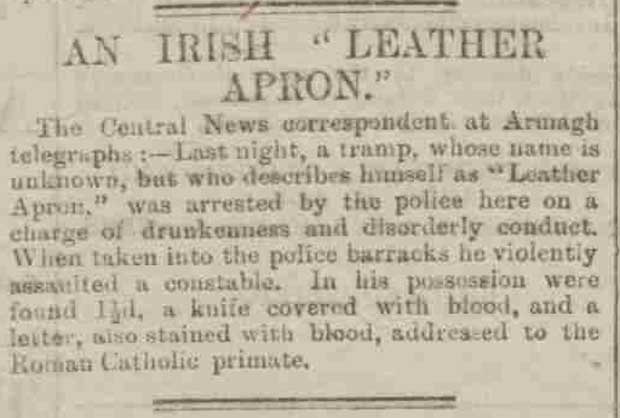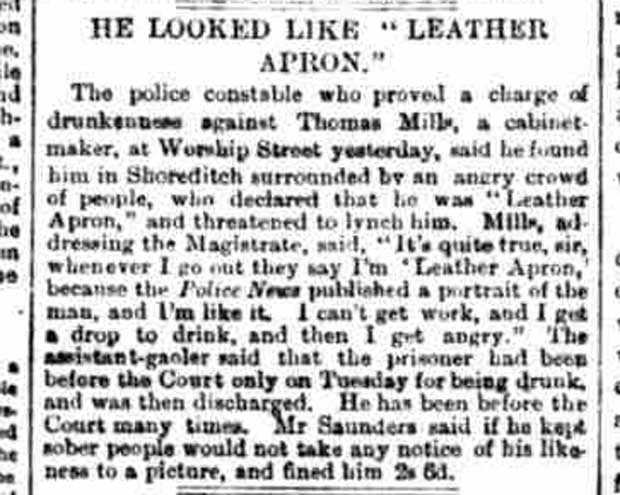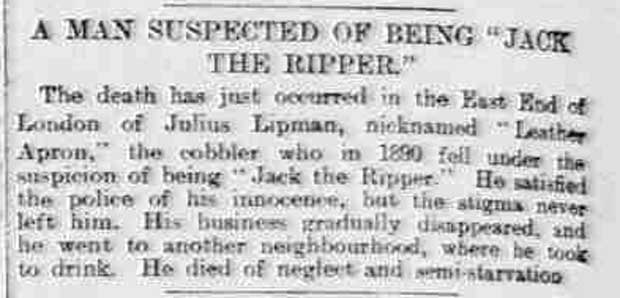One of the aspects that is noticeable from the press reporting on the Whitechapel murders is the fact that, to certain young men, the murders were being seen as a source of fun and they considered it a great lark to impersonate “Jack the Ripper.”
However that name had only been circulating for a little over a month in November 1888 and many people were, apparently, still referring to the murderer under the name that the newspapers were using throughout September 1888 – Leather Apron.
Just as with the growing popularity for people to use the name”Jack the Ripper”, people – mostly when in their cups – were still claiming to be “Leather Apron” throughout October.
So, today. I thought it might be nice to do a Leather Apron Round Up.
AN IRISH LEATHER APRON
Our first report is taken from the October 5th, 1888 edition of The Sunderland Daily Echo and Shipping Gazette and discusses a tramp in Armagh, whose name was unknown. Having over imbibed, he started informing onlookers that he was, indeed, “Leather Apron.” The police promptly arrested him for being drunk and disorderly and took him to the police barracks where he went on to violently assault a police constable. The fact that he was in possession of a knife that was covered in blood is interesting, although it only merited a passing mention in the subsequent newspaper reports.

MISTAKEN IDENTITY
An altogether different experience befell a sailor by the name of John Lock on the evening of the 3rd of October 1888.
At around 6pm on that day, the police were called to a disturbance in the neighbourhood of Ratcliffe Highway where they found a man being pursued by a frenzied mob who were shouting “Leather Apron” and “Jack the Ripper” at him.
He was taken to the nearest police station where, on examination, it was discovered that his clothes bore stains of red paint, which the crowd had evidently mistaken for blood.
However, according to newspaper reports, it was “some considerable time” before the police could release him, as the mob had surrounded the police station convinced that the perpetrator of the Whitechapel murders was finally in custody.
A DUNDEE LEATHER APRON
On 12th September 1888, the Dundee Advertiser carried the story of a Dundee shoemaker who, having read the “harrowing details” of the murders in Whitechapel, had become “intensely interested in the doings of Leather Apron.”
While “downtown” he met with several of his friends and, having consumed considerable amounts of spirits, he proceeded to hold forth on the doings of Leather Apron.
The Dundee Advertiser reported what happened next:-
“Drink has played many a trick upon humanity in its day, and the shoemaker by and by became madly bewildered. The only object he appeared to see through the fogs begotten of his potations was “Leather Apron.”
From intense meditation on the deeds of this individual, our shoemaker friend appears in the last stages of carousal to have lost his own individuality, which became merged into that of the London terror.
11 o’clock found him in the public house talking mysteriously until it came time for him to leave.
Outside he began to carry out the character of his hero and his first operations were directed against a shop window. This he managed to smash, before his destructive tendencies had got time for further development a policeman appeared on the scene, and in a few minutes the shoemaker was sitting ruminating behind an iron barred door in a corner at Mr Dewar’s “establishment.”
Early next morning the turnkey paid him a visit, and found him in sore distress. He had not shaken himself clear of the alcohol he had imbibed, and there was still the idea lingering in his mind that he was the veritable “Leather Apron.” He asked the turnkey: “What a’ hae dune?” The turnkey replied: “broken a shop window, I believe.” “Is that a?” Queried the prisoner. “That’s a!” Replied the turnkey: “do you not think it’s enough?” “Then I canna’ be leather apron after a'” said the man, to the surprise of the prison official.
After a prolonged meditation in the cells the man recovered sufficiently to be able to let the secret out, and added: “I really thought I was Leather Apron. I’m a shoemaker you see.”
A FEMALE LEATHER APRON
Back in London, on 20th October 1888, Blanche Cox, found her self in Marylebone Police Court on a charge of being drunk and disorderly.
Opening the case against her, the Police Constable (104Y) who had arrested her, testified that he had “found the prisoner in Kentish Town Road at 1 o’clock in the morning, very drunk, and behaving in a very unbecoming manner, in the presence of a number of young men. Her conduct was most disgraceful, so he took into custody.”
The Magistrate asked the formidable Blanche Cox what she had to say for herself, to which she replied, “I don’t know your worship I was talking to Mr Barrett [the assistant-gaoler] whilst the policeman was giving his evidence.” At this point Inspector Collins piped up and told the magistrate that she was, in fact, “threatening to smack the assistant gaoler’s face, Sir.”
This, in turn, caused Mr Barrett to inform the Magistrate, Mr De Rutzen, that the prisoner had already smacked his face once that morning.
Turning angrily to Cox, the Magistrate told her to behave herself and asked again what she had to say about her being drunk.
“Well, I know I was drunk”, came her reply, “I don’t even remember being taken to the station.”
“Have you any witnesses to call?” The magistrate asked her impatiently.
“If I was drunk, and don’t recollect anything, how can I have witnesses to call?” Was her flippant retort.
The Magistrate then enquired of the assistant-gaoler as to when she was last before him.
“The 20th of last month, your worship,” was Mr Barrett’s reply.
“Yes, I got 21 days for breaking a window”, piped up the prisoner.
“How many times has she been in here?” De Rutzen then asked Barrett. “Nineteen times,” was the reply – at which the prisoner interjected” and I’ll make it up to 20 today. I’ll be like”Leather Apron,” I’ll give in then.” This statement caused the courtroom to erupt with laughter.
Unamused, the magistrate sentenced her to 7 days imprisonment.
As she left the dock, she turned to Mr Barrett and, grinning at him, said in a sarcastic tone “God bless you.” Whereupon, according to Reynolds Weekly, she then “went down the court passage jumping and dancing.”
I’M LEATHER APRON
In mid-September, 1888, at Lambeth Police Court, Walter Surridge, aged 23, whose occupation was given as a silversmith, was charged with violently assaulting Ann Nunnery, by striking and kicking her.
Giving evidence, Miss Nunnery, recalled how she had been walking along Lyndhurst Road when the prisoner had stopped her. He asked her to have something to drink and she consented. Afterwards, in the street, she put out her hand and said she must bid him good night. Surridge’s response was to shout at her “I’m Leather Apron.” He then proceeded to rush at her and, striking her, he knocked her to the ground. As she attempted to rise, he kicked her several times, hurting her very much.
A passer-by, Mr Goddard, intervened and, catching hold of Surridge, he prevented him kicking her again.
At this point a police constable arrived took Surridge into custody.
Walter Surridge apologised in court and the Magistrate, Mr Biron, sentenced him to two months hard labour.
POOR OLD THOMAS MILLS
Another man who found the scare being generated by the same murder suspect in September 1888 was cabinet-maker Thomas Mills, who appeared before Mr Saunders, the Magistrate, at Worship Street Police Court on the 20th September 1888. He had, so the police officer who arrested him for drunkenness told the court, been surrounded by an angry crowd who were declaring in no uncertain terms that he was “Leather Apron.”
Explaining his behaviour to the court, Thomas Mills, informed the Magistrate that his life had been made unbearable by the fact that the Illustrated Police News had published a portrait of the suspect and, since it bore an uncanny resemblance to him [Mills], every time he went out he would be accused of being “Leather Apron.” “I can’t get work,” he lamented, “and I get a drop to drink and then I get angry.” The magistrate informed him that, if he stayed sober, people probably wouldn’t take any notice of his likeness to the picture. He fined him 2 shillings and sixpence.

THE DEATH OF JACK THE RIPPER
In October 1900, several newspapers were reporting on the death of a man who had been suspected of being “Jack the Ripper.”
Apparently, Julius Lipman – whose nickname, so the Nottingham, Evening Post informed it readers, was “Leather Apron – had just died in the East End of London.
According to the newspaper, in 1890 Lipman had fallen under suspicion of being Jack the Ripper and, although he was able to convince the police of his innocence, the stigma never left him. His business, as a cobbler, consequently dried up and he was forced to move to another neighbourhood, where he took to drink. He died, so the post reported, “of neglect and semi-starvation.”

So there you have a round up of Leather Aprons. Ordinary men and women who either injected themselves into the saga of the Whitechapel Murders, or were injected into it by gossip and circumstance.
